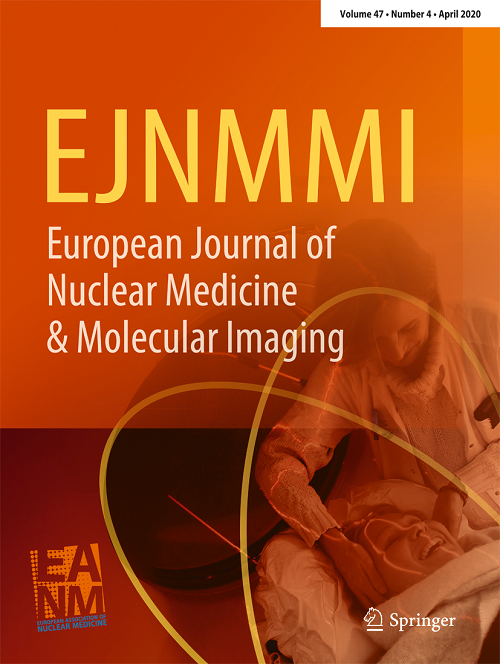Prognostic utility of 18F-FDG PET/MRI with intravoxel incoherent motion imaging in nasopharyngeal carcinoma.
IF 8.6
1区 医学
Q1 RADIOLOGY, NUCLEAR MEDICINE & MEDICAL IMAGING
European Journal of Nuclear Medicine and Molecular Imaging
Pub Date : 2025-07-02
DOI:10.1007/s00259-025-07425-6
引用次数: 0
Abstract
PURPOSE Intravoxel incoherent motion (IVIM) diffusion-weighted imaging (DWI) enhances tissue diffusion assessment by differentiating true molecular diffusion from microvascular perfusion, surpassing conventional DWI. This prospective study assessed the prognostic utility of 18F-FDG PET/MRI with IVIM imaging in patients with primary nasopharyngeal carcinoma (NPC). METHODS We prospectively enrolled 148 patients with primary NPC who underwent pretreatment PET/MRI. Quantitative parameters derived from IVIM-DWI, dynamic contrast-enhanced MRI (DCE-MRI), and 18F-FDG PET were analyzed for their associations with overall survival (OS) and recurrence-free survival (RFS). RESULTS IVIM-derived minimal true diffusion coefficient (Dmin) and perfusion-related diffusion coefficient (D*) were correlated with RFS (p = 0.018 and 0.043, respectively), outperforming the apparent diffusion coefficient (ADC; p = 0.946). Univariate analysis identified age, tumour stage, T classification, primary tumour standardized uptake value (SUVt), nodal SUV (SUVn), and total lesion glycolysis (TLG) as significant OS predictors. Significant predictors of RFS included Epstein-Barr virus DNA titer, SUVn, DCE-MRI parameters (Kep and Ve), and IVIM parameters (D* and Dmin). In multivariate analysis, age, SUVt, and TLG were independent OS prognostic factors, whereas SUVn, Kep, Dmin (p = 0.009), and Ve (p = 0.012) independently predicted RFS. Prognostic models incorporating the PET/MRI imaging biomarkers showed a significantly higher integrated AUC and Harrell's C-index than the TNM staging system alone. CONCLUSION Integrated PET/MRI with IVIM imaging enables simultaneous quantification of water molecule diffusion, tumor microvascular perfusion, and glucose metabolism in NPC, yielding complementary imaging biomarkers that demonstrate superior prognostic value compared to conventional TNM staging. TRIAL REGISTRATION ClinicalTrials.gov (NCT03429868), retrospectively registered on February 6, 2018.18F-FDG PET/MRI结合体内非相干运动成像在鼻咽癌中的预后价值。
目的:体素内非相干运动(IVIM)扩散加权成像(DWI)通过区分真正的分子扩散和微血管灌注来增强组织扩散评估,超越传统的DWI。这项前瞻性研究评估了18F-FDG PET/MRI结合IVIM成像在原发性鼻咽癌(NPC)患者中的预后价值。方法前瞻性纳入148例原发性鼻咽癌患者,接受PET/MRI预处理。分析了IVIM-DWI、动态对比增强MRI (DCE-MRI)和18F-FDG PET得出的定量参数与总生存期(OS)和无复发生存期(RFS)的关系。结果vims导出的最小真扩散系数(Dmin)和灌注相关扩散系数(D*)与RFS呈正相关(p分别为0.018和0.043),优于表观扩散系数(ADC;p = 0.946)。单因素分析发现,年龄、肿瘤分期、T分类、原发肿瘤标准化摄取值(SUVt)、淋巴结SUV (SUVn)和病变总糖酵解(TLG)是显著的OS预测因子。Epstein-Barr病毒DNA滴度、SUVn、DCE-MRI参数(Kep和Ve)、IVIM参数(D*和Dmin)是RFS的显著预测因子。在多因素分析中,年龄、SUVt和TLG是独立的OS预后因素,而SUVn、Kep、Dmin (p = 0.009)和Ve (p = 0.012)是独立的RFS预测因素。结合PET/MRI成像生物标志物的预后模型显示,综合AUC和Harrell c指数明显高于单独的TNM分期系统。结论PET/MRI结合IVIM成像可同时定量鼻咽癌的水分子扩散、肿瘤微血管灌注和糖代谢,与传统的TNM分期相比,提供了互补的成像生物标志物,具有更好的预后价值。临床试验注册(NCT03429868),回顾性注册于2018年2月6日。
本文章由计算机程序翻译,如有差异,请以英文原文为准。
求助全文
约1分钟内获得全文
求助全文
来源期刊
CiteScore
15.60
自引率
9.90%
发文量
392
审稿时长
3 months
期刊介绍:
The European Journal of Nuclear Medicine and Molecular Imaging serves as a platform for the exchange of clinical and scientific information within nuclear medicine and related professions. It welcomes international submissions from professionals involved in the functional, metabolic, and molecular investigation of diseases. The journal's coverage spans physics, dosimetry, radiation biology, radiochemistry, and pharmacy, providing high-quality peer review by experts in the field. Known for highly cited and downloaded articles, it ensures global visibility for research work and is part of the EJNMMI journal family.

 求助内容:
求助内容: 应助结果提醒方式:
应助结果提醒方式:


